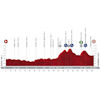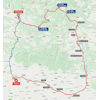Vuelta 2020 Route stage 5: Huesca - Sabiñánigo

Slideshow 1/5
Saturday 24 October - The 5th stage on La Vuelta is played out in the foothills of the Pyrenees. Following a gently rolling route for 115 kilometres the last 70 kilometres are quite demanding. The last 16 kilometres descend into Sabiñánigo.
The first part of the 8th stage is likely to see plenty of action. The terrain is not too demanding, so virtually all riders could give it a shot to make it into the breakaway. Winning the race is something else though with three climbs in the last 70 kilometres.
The first uphill is the Alto de Vio: a narrow road of 13.5 kilometres to an elevation of 1,265 metres. It is a steady climb with an average gradient of 4.7%.
Following a short downhill the route continues to climb to the highest point of the day. The Alto de Fanlo is 6.4 kilometer long and rises mostly at around 4%. Yet, the last kilometres serve a number of sections at double digit gradients.
The riders move through Fanlo – a village at an elevation of 1,365 metres – before flying down a 22 kilometres descent into Fiscal. It is here that the Alto de Petralba, an ascent on a wide road with two tunnels, kicks in hard. The first 3 kilometres and a section halfway – right after the Berroy tunnel – are toughest with ramps up to 9.5%. The second tunnel is 2.6 kilometres long and ends just before the summit. The Petralba climb is 8.5 kilometres long with an average gradient of 5.2%.
The last 16 kilometres are played out on the same wide road. The riders plunge down into Sabiñánigo, where the last 2 kilometres are a false flat run-in to the line.
Greg Van Avermaet is the last rider to win a Vuelta stage in the town in the foothills of the Pyrenees. In 2008, the Olympic Champion of Rio outgunned Davide Rebellin and Juan Antonio Flecha.
The intermediate sprint – located just before the Alto de Petralba – comes with time bonuses of 3, 2 and 1 seconds, while the first three riders on the line gain 10, 6 and 4 seconds.
Another interesting read: results 5th stage 2020 Vuelta a España.
Vuelta a España 2020 stage 5: route, profiles, more
Click on the images to zoom
+ Click for more images (2)
Watch the highlights of recent races here:
Related articles Riders - Vuelta 2020 Withdrawals - Vuelta 2020 Route and stages - Vuelta 2020 GC Favourites - Vuelta 2020 More articles Tour de Romandie 2025: Evenepoel wins ITT, overall victory for Almeida
Vuelta Femenina 2025: Lidl–Trek wins opening team time trial, Van Dijk first leader
Vuelta Femenina 2025 Route stage 2: Molins de Rei - Sant Boi de Llobregat
Vuelta Femenina 2025: Riders
Giro 2025: The Route
Giro 2025: Riders
Giro 2025: GC Favourites
Giro 2025 Route stage 1: Durazzo - Tirana
Giro 2025 Favourites stage 1: Puncher's sprint for pink
Giro 2025 Route stage 2: Tirana - Tirana
Giro 2025 Favourites stage 2: Chrono specialists to the fore
Giro 2025 Route stage 3: Valona – Valona
Giro 2025 Favourites stage 3: Breakaway day
Giro 2025 Route stage 4: Alberobello – Lecce
Giro 2025 Favourites stage 4: For fast men #1
Giro 2025 Route stage 5: Ceglie Messapica - Matera
Giro 2025 Favourites stage 5: For fast men #2
Giro 2025 Route stage 6: Potenza - Naples
Giro 2025 Favourites stage 6: Hilly race with flat finale
Giro 2025 Route stage 7: Castel di Sangro - Tagliacozzo
Giro 2025 Favourites stage 7: First mountain top finish
Giro 2025 Route stage 8: Giulianova – Castelraimondo
Giro 2025 Favourites stage 8: Attackers in the Apennines
Cycling Calendar 2025
Tour de France 2025: The Route
Tour de France 2025 Route stage 1: Lille - Lille
Tour de France 2025 Route stage 2: Lauwin-Planque - Boulogne-sur-Mer
Tour de France 2025 Route stage 3: Valenciennes - Dunkirk




